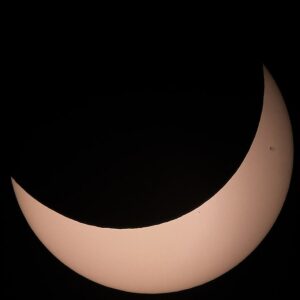
Since I live in the Southern Hemisphere, I missed the solar eclipse of 2024. But today, with high definition media and thousands of cell phone cameras, I was able to witness it by proxy many times over, and also hear the “Oh My Gods” and “Wows” of the crowds. It was moving indeed. Many related that it was close to a mystical experience. I do not wish for a moment to dampen the enthusiasm, but there is a far deeper lesson on display which I suspect most people miss when we watch the cool lunar orb fit perfectly atop the hot disk of our blazing sun.
We learn from astronomers that the diameter of the Sun, in its naked physical reality, is around 400 times that of the Moon; or, shifting to solid measures, that you could drop more than 64,000,000 Moon-sized marbles into an empty Sun-sized sphere. Curiously, though – and obeying no imperious law of physics – the Sun happens to be about 400 times the distance from us as is the Moon. This means that these totally incommensurate balls of light, while dominating our firmament, disregard the physics of their masses and tease us with their conspicuous equality. But they do this in a way that is too grandiose to be a trick, and too choreographed to be an accident. The only difference is that one emits its light, while the other reflects it. Of all the multiple fine-tunings in our local corner of the cosmos, this is certainly the most visible and the most unlikely. So why does the solar eclipse seem packed with mystery and meaning to those who view it – soliciting all those oohs and ahs? It must be because of this meticulous aesthetic touch, the dimensions of which the astronomers can measure, but the meaning of which they cannot fathom. But those with eyes to see will see today, as they have always seen, the unmistakable trademark of a transcendent Artist.



